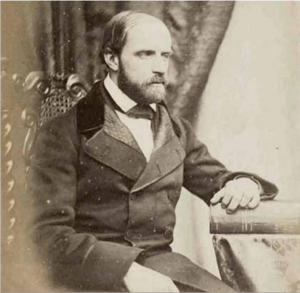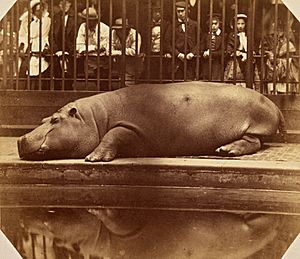Infante Juan, Count of Montizón facts for kids
Quick facts for kids Infante Juan |
|
|---|---|
| Count of Montizón | |
 |
|
| Carlist pretender to the Spanish throne as Juan III |
|
| Pretendence | 13 January 1861 – 3 October 1868 |
| Predecessor | Carlos VI |
| Successor | Carlos VII |
| Legitimist pretender to the French throne as Jean III |
|
| Pretendence | 24 August 1883 – 21 November 1887 |
| Predecessor | Henri V |
| Successor | Charles XI |
| Born | Don Juan Carlos María Isidro de Borbón y Braganza and Jean Charles Marie Isidore de Bourbon 15 May 1822 |
| Died | 18 November 1887 (aged 65) |
| Spouse |
Maria Beatrix of Austria-Este
(m. 1847) |
| Issue | Infante Carlos, Duke of Madrid Infante Alfonso Carlos, Duke of San Jaime Helen Monfort John Monfort |
| House | Bourbon |
| Father | Infante Carlos María Isidro of Spain |
| Mother | Infanta Maria Francisca of Portugal |
Juan Carlos María Isidro de Borbón, Count of Montizón (born May 15, 1822 – died November 18, 1887) was an important figure in European royal history. He was a claimant to the throne of Spain from 1860 to 1868, supported by a group called the Carlists. He also claimed the throne of France from 1883 to 1887, as a Legitimist. For a short time, he was even considered as a possible ruler for Mexico.
Contents
Early Life
Juan was born in the Palacio Real de Aranjuez in Madrid, Spain. He was the younger son of Infante Carlos María Isidro of Spain. His uncle was King Ferdinand VII. Juan grew up learning about the importance of loyalty to the monarchy and the Church.
In March 1833, Juan and his family moved to Portugal. Later that year, his uncle King Ferdinand VII died. Juan's father, Carlos, then claimed the Spanish throne as King Carlos V. However, Ferdinand VII's young daughter, Isabella II, became queen with her mother, Maria Christina, acting as regent.
In June 1834, Juan's family moved to England. They lived there during the First Carlist War, a conflict over who should rule Spain. Juan was too young to take part in this war.
In 1837, the Spanish parliament, called the Cortes, passed a law. This law removed Juan, his father, and his brothers from the line of succession to the Spanish throne. It also took away their title of Infante of Spain. However, the Carlists did not accept this law.
Family Life
On February 6, 1847, Juan married Maria Beatrix of Austria-Este. She was the daughter of Francis IV, Duke of Modena. Juan and Beatrix had two sons:
- Infante Carlos, Duke of Madrid (1848–1909)
- Infante Alfonso Carlos, Duke of San Jaime (1849–1936)
The family first lived in Modena, Italy. But they had to leave during the revolutions of 1848. After a short time in Austria, they settled in London. Juan had more modern ideas than his family and his wife. Because of their different views, Juan and Beatrix separated. Beatrix returned to Modena and raised their two sons there.
Later, Juan lived with Ellen Sarah Carter, an English woman. They had two children together:
- Helen Mary Anne Joan Monfort (1859-1947)
- John Monfort (1861-1929)
Juan and Ellen Carter lived together until Juan's death. After he passed away, his sons Carlos and Alfonso paid a regular allowance to Helen and John. Today, many of John's descendants live in the UK, Norway, and Canada.
Claiming the Spanish Throne
Juan did not take part in the Carlist uprising of 1860, which was led by his brother, Carlos Luis. On April 21, Carlos Luis was captured by Queen Isabella II's soldiers. He was forced to give up his claim to the Spanish throne.
On June 2, Juan announced that he was now the rightful King of Spain, calling himself Juan III. He began using the title conde de Montizón. However, Juan's modern ideas upset many Carlists, and most of them did not support him.
After being released, his brother Carlos Luis said that his abdication was not valid because he had been forced to sign it. This meant that for a short time, there were two Carlist claimants to the throne.
In the early 1860s, Queen Isabella II's government became less popular. But Juan's liberal views still made him an unpopular choice for the Carlists. In 1866, Juan's older son, Carlos, asked his father to give up his claims. Two years later, on October 3, 1868, Juan signed a document in Paris giving up his claim. He then actively supported his son Carlos's efforts to become King of Spain in the Third Carlist War.
Claiming the French Throne
On August 24, 1883, Juan's distant cousin and brother-in-law, Henri, comte de Chambord, died. Henri had been the Legitimist claimant to the throne of France. Some of Henri's supporters believed that Juan, as the oldest male descendant of Louis XIV, should be the next claimant.
They declared him Jean III, King of France and Navarre. Juan stated that he would not give up his rights to the French throne. However, he did not actively try to become King of France.
Candidate for the Mexican Throne
When the Mexican Empire became independent in 1821, its first plan was to be ruled by Ferdinand VII. Even though he said no, many Mexican conservatives still hoped to have a Bourbon ruler as Emperor of Mexico.
During a meeting in London in 1861, Juan, Count of Montizón, was suggested as a possible ruler for Mexico. But he turned down the offer. So, the Mexican conservatives chose Archduke Ferdinand Maximilian instead, who accepted the throne.
Hobbies
Juan was very interested in photography. He was one of the first members of the Photographic Society (which later became the Royal Photographic Society) in 1853. He was a member until 1866.
Death
Juan died from a heart condition at his home in Hove, England, on November 18, 1887. His body was later moved to the Church of the Sacred Heart in Hove. His two sons attended his funeral.
On January 6, 1888, his body was moved from Hove to London, along with the body of his mother, Queen Maria Francisca. Their bodies were then taken by ship to Hamburg, and then by land through Berlin and Vienna to Trieste. He is buried in the chapel of Saint Charles Borromeo in Trieste Cathedral. The inscription on his tomb calls him the King of Spain.
See also
 In Spanish: Juan de Borbón y Braganza para niños
In Spanish: Juan de Borbón y Braganza para niños


